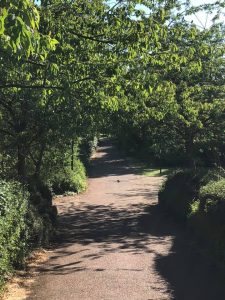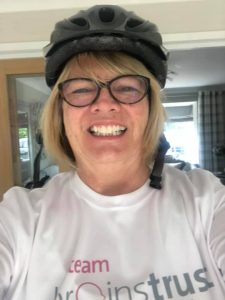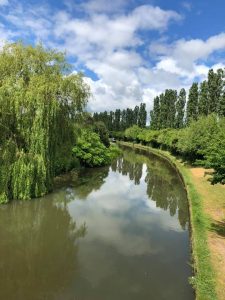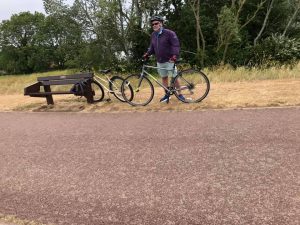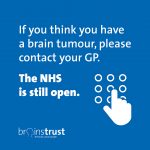Margaret’s Run, Row, Ride: LOCKDOWN EDITION diary
I have just signed up for brainstrust latest Run Row Ride Challenge. I really enjoyed the last one in November and I learnt so much about myself and what I am capable of. This time around it will require more effort and determination as I only completed six weeks of stereotactic radiotherapy on 6th April and Fatigue comes to say hello quite frequently. I tell it politely to go away but it does not always listen! Stronger tactics are required, hence the decision to accept the 30 miles in 30 days challenge.
Day One
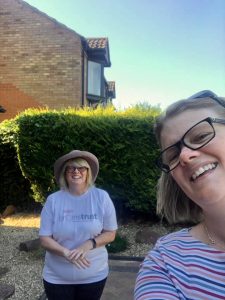
Awake bright and early, excited to be challenging myself again. I was joined by fellow brainstrust member and friend Jaime. I was touched and encouraged when she messaged me and offered to join me on my first walk.
I am no where near as fit as when I completed the November challenge, having recently completed 6 weeks of stereotactic radiotherapy, but I will get there.
Jaime suggested we walk Tongwell Lake. It is exactly a mile around the lake (and half a mile to get there from my house). A little out of my comfort zone as I haven’t walked or run around the lake for many, many years. It was a stunning morning, the trees and bushes have matured beautifully since I was last here and it was great walk the route with such supportive company!
Happy Monday everyone!
Day Two
I felt really weary this morning. Trying to be sensible and listen to my body, I chose to have a quiet day and to leave my walk ( with a bit of a jog) until early evening when it was a little cooler.
I was a little worried that I might have taken on more than I was capable of at this stage in my BT journey but as soon as I set out in the warm evening sunshine my spirits lifted, energy flooded into my body and off I went, slowly but surely.
I stopped at the bridge to take a photo of the canal boat and then to check on the swans nest. Initially I was concerned as there was not a swan sitting on the nest but imagine my delight when a few hundred yards later I spotted the proud parents gliding around the boat basin with seven cygnets in tow!
So worth the effort. Thankful to have this on my doorstep. I can and I will do this!
It was a tremendous Tuesday!!
Love 💕 to all.
Margaret xx
Day Three
Think the smile says it all.
Having discovered my bike in the shed (if were a betting woman I would have put good money on the fact that this had gone to the tip years ago! ) and having ordered a cycle helmet which arrived this morning (men’s large- I have a massive head) my ever supportive husband encouraged me to go on a flat bike ride with him this morning. I have been practicing getting on and off for a while and pedaling round the driveway .
I felt a little anxious and was wobbling a little at first, rather like a snake slithering along the path but once I got going it was fabulous! Took me back to my former life with spin classes at the gym. I felt free and invincible (until I got to an incline). I will master appropriate gear changes and my legs will get stronger.
One day walking, one day cycling I will manage this challenge. 3.41 km today. Not bad for a 63 year old woman having had a craniotomy 3 years ago and 6 weeks of stereotactic radiotherapy earlier this year.
Never give up on yourself.
Wonderful Wednesday.
Love and strength to all.
Margaret
Day Four
This morning I felt really tired. The euphoria of yesterday and managing to successfully ride my bike again had given way to a feeling of frustration that my energy levels today were virtually non existent.
After a stern talking to myself, I washed, dressed, put makeup on , grabbed my hat and got my mile in.
So pleased to be doing this challenge otherwise I think I might just have stayed in feeling sorry for myself. Family and friends have been so supportive and encouraging which spurred me on.
Once I was out and closed the front door I immediately felt much better. I took pictures of the community garden that has gradually been developed by the owners of one of the bungalows by the playground. They work so hard in all weathers to brighten up the area. As always my mood improved at the sight of the beautiful flowers as I headed towards the canal.
Hoping that Thursday was kind to you.
Margaret x
Day Five
How the weather has changed since the beginning of the week.
Today I decided to grab the opportunity in between showers to get out for my daily mile. The weather definitely affects how I feel and my ability to achieve. I have learnt however that I DO feel better if I get outside in the fresh air.
It was a mixture of walking, jogging and stopping to take in the views and the sounds of nature on my doorstep.
I checked on the swans, sitting on the nest today. I saw ducks, moorhens and many different species of bird.
Stepping out of my comfort zone again I jogged along the towpath and by some miracle I did not fall in!
This week is not about beating last year’s times or even about recording times.
Success is about getting out there every day and doing at least a mile .
It is about proving to myself that the belief of friends and family has been justified and that their donations to my just giving page will enable Brainstrust to carry on offering help and support to those who need it.
Mission accomplished for today!!
It is a fabulous Friday!!
Much love
Margaret x
Day Six
On my bike in this strong wind. Just home and my cheeks are burning, my knees are shaking and my bottom aches!
Bob is a hard task master but I did it, only one incline I had to walk up. Getting stronger and more confident.
That’s me done for soggy Saturday!
Much love
Margaret x
Day Seven
I didn’t think my poor derrière could take another bike ride this morning so along with my lovely friend Wendy we took her dog Rossi for a wonderful brisk walk along the canal. 6km.
We chatted non stop for an hour and a half. She has been a friend for over 30 years and is one of my group of friends known collectively as Maggie’s Maidens.
Throughout my BT journey she has always been there offering support, encouragement, Sunday lunches (before lockdown), walks, lifts, afternoon teas to both Bob and I. She was also one of the team of people who helped with lifts to Oxford during my recent stereotactic radiotherapy.
One of life’s special people. She told me today that she has put brainstrust forward as her company’s charity of the year. She will find out next week if she has been successful. Fingers crossed.
Reflection on week one.
The first couple of days were so hard. Radiotherapy certainly knocks the stuffing out of you, however much you try and pretend it hasn’t. If I hadn’t accepted this challenge I most certainly would not have carried on. However I’m sat here today feeling energised and quite amazed at what have achieved in 7 days.
My energy levels, although still variable, have increased.
I am humbled by the support of family and friends on my just giving page.
I feel more positive about the future.
I am looking forward to getting back on my bike tomorrow!!!
I never thought I would be saying that .
A successful Sunday for me. I hope it is for you too.
Love to all
Margaret x

